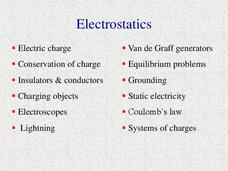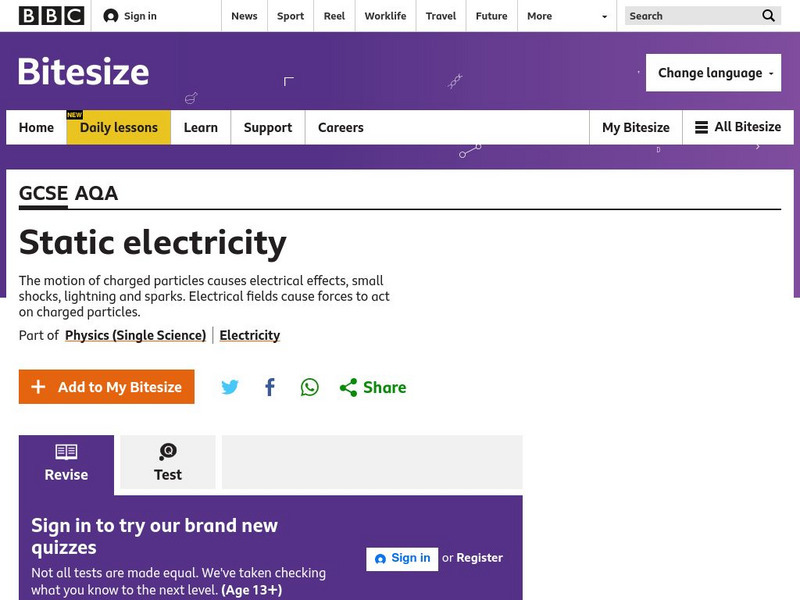Concord Consortium
Van de Graaff Discharge
Your class will definitely get a charge out of an electric interactive! Show young scientists what really happens when you place a wand near a Van de Graaff generator using a simulation. Pupils add varying amounts of negative charge to...
Curated OER
Van de Graaff Generator
Students explore static electricity using the Van de Graaff generator. In this physics lesson, students construct their own Van de Graaff using simple materials. They explain how charges accumulate on this device.
Concord Consortium
Direction of Force Around a Van de Graaff—Negatively Charged
Learn about the direction of magnetic force with a very attractive interactive! Young physicists move a positively charged object around a negatively charged Van de Graaff generator and observe the direction of the forces present. A...
Curated OER
Exploring Electricity - Four Activities
These are four classic activities used for instructing upper elementary electricians. The first involves experimenting with the Van de Graaff generator. The second is a series of hands-on experiences with static. In the third activity,...
Urbana School District
Electrostatics
Why did lightning shock the man? Because it didn't know how to conduct itself. Presentation covers electric charges, insulators, conductors, electroscopes, lightning, generators, grounding, static electricity, and more. Presentation is...
Curated OER
Electricity
Learners explore electricity. After watching a PowerPoint presentation, students discuss the composition of electricity and how it is made. They participate in discovery activities by rotation through four activity stations set up on the...
Curated OER
TE Activity: Build a Charge Detector
Young scholars examine how electrical force takes place between two objects by building an electroscope. They apply the electroscope to determine an objects' charge intensity and to see what factors influence electric force.
National High Magnetic Field Laboratory
Magnet Academy: Van De Graaff Generator
Invented around 1930, the Van de Graaff generator is a popular tool for teaching the principles of electrostatics. Others just call it "that thing that makes your hair stand on end." See how it works here.
Concord Consortium
Concord Consortium: Van De Graaff Discharge
Charge up the Van de Graaff generator and drag the discharge wand close enough to form a spark. What happens to the electric potential energy when you charge the Van de Graaff and when the spark occurs?
National High Magnetic Field Laboratory
Magnet Academy: Electrostatic Repulsion in Van De Graaff Bubbles
A fun look at how Van de Graaff generators illustrate electrostatic forces. (Java tutorial)
Wikimedia
Wikipedia: Van De Graaff Generator
A Wikipedia description of how a Van de Graaff generator works.
University of Kentucky
University of Kentucky: Van De Graff Generator
Provides the physics behind a Van de Graaff generator at an introductory high school level.
Lawrence Berkeley National Laboratory
Berkeley Lab: Van De Graaff
Featured is a brief description of the Van de Graaff accelerator and its uses.
Concord Consortium
Concord Consortium Where Does the Energy of a Spark Come From?
Students define potential energy and explore the relationship between potential energy and field. How does potential energy change when things are pushed or pulled? Where does the energy that was used to charge the Van de Graaff...
Concord Consortium
Concord Consortium Where Does the Energy of a Spark Come From?
Activity 2 of the module investigates Where does the energy used to charge the Van de Graaff generator go? The activity investigates how objects can interact without touching, as well as what happens to potential energy when objects...
Concord Consortium
Concord Consortium: Where Does the Energy of a Spark Come From?
Activity 4 of this module investigates Why do I get shocked if I am too close to the Van de Graaff generator? This activity explores what happens to the potential energy of a system when objects are allowed to move freely (not held in...
Concord Consortium
The Concord Consortium: What Are Some Examples of Things That Stick Together and Things That Do Not?
In this learning module from The Concord Consortium, students will watch what happens when a Van de Graaff generator is used.
University of Wisconsin
University of Wisconsin: 4 Electricity
A description of several demonstrations for static electricity concepts. The demonstrations utilizing the Telsa coil, Faraday cage, and Van de Graaff generator are ideal for demonstrating electric potential concepts. Suitable for student...
Other
Rhic Virtual Tour
Virtual tour takes you through the Relativistic Heavy Ion Collider. The first stop is the Tandem Van de Graff accelerator.
BBC
Bbc: Gcse Bitesize: Static Electricity
This lesson focuses on static electricity, including how particles can be charged by friction, and electrical forces and why they repel or attract each other. Includes a link to a test.
Concord Consortium
Concord Consortium: What Are Factors That Affect How Strongly Objects Interact With Each Other?
Explore and use models of electric fields to explain how charged objects interact with other objects.
Concord Consortium
Concord Consortium: What Is Happening When a Spark Occurs?
Activity 1 in this module investigates Can my finger start a fire?
Science and Mathematics Initiative for Learning Enhancement (SMILE)
Smile: Electrostatics
From the Science and Mathematics Initiative for Learning Enhancement project at the Illinois Institute of Technology. A teacher lesson plan which includes several Van de Graaff generator demonstrations and some station-style labs....
















